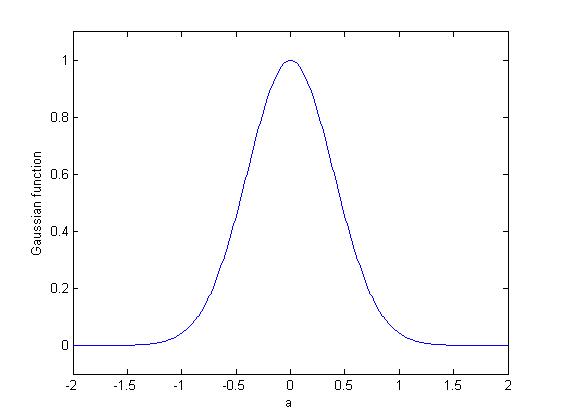|
Adaptive Gabor Representation
Adaptive Gabor representation (AGR) is a Gabor representation of a signal where its variance is adjustable. There's always a trade-off between time resolution and frequency resolution in traditional short-time Fourier transform (STFT). A long window leads to high frequency resolution and low time resolution. On the other hand, high time resolution requires shorter window, with the expense of low frequency resolution. By choosing the proper elementary function for signal with different spectrum structure, adaptive Gabor representation is able to accommodate both narrowband and wideband signal. Gabor expansion In 1946, Dennis Gabor suggested that a signal can be represented in two dimensions, with time and frequency coordinates. And the signal can be expanded into a discrete set of Gaussian elementary signals. Definition The Gabor expansion of signal s(t) is defined by this formula: : s(t)=\sum_^\infty \sum_^\infty C_h(t-mT)e^ where ''h''(''t'') is the Gaussian elementary function: ... [...More Info...] [...Related Items...] OR: [Wikipedia] [Google] [Baidu] |
Dennis Gabor
Dennis Gabor ( ; hu, Gábor Dénes, ; 5 June 1900 – 9 February 1979) was a Hungarian-British electrical engineer and physicist, most notable for inventing holography, for which he later received the 1971 Nobel Prize in Physics. He obtained British citizenship in 1934, and spent most of his life in England. Life and career Gabor was born as Günszberg Dénes, into a Jewish family in Budapest, Hungary. In 1918, his family converted to Lutheranism. Dennis was the first-born son of Günszberg Bernát and Jakobovits Adél. Despite having a religious background, religion played a minor role in his later life and he considered himself agnostic. In 1902, the family received permission to change their surname from Günszberg to Gábor. He served with the Hungarian artillery in northern Italy during World War I. He began his studies in engineering at the Technical University of Budapest in 1918, later in Germany, at the Charlottenburg Technical University in Berlin, now known as t ... [...More Info...] [...Related Items...] OR: [Wikipedia] [Google] [Baidu] |
Short-time Fourier Transform
The short-time Fourier transform (STFT), is a Fourier-related transform used to determine the sinusoidal frequency and phase content of local sections of a signal as it changes over time. In practice, the procedure for computing STFTs is to divide a longer time signal into shorter segments of equal length and then compute the Fourier transform separately on each shorter segment. This reveals the Fourier spectrum on each shorter segment. One then usually plots the changing spectra as a function of time, known as a spectrogram or waterfall plot, such as commonly used in software defined radio (SDR) based spectrum displays. Full bandwidth displays covering the whole range of an SDR commonly use fast Fourier transforms (FFTs) with 2^24 points on desktop computers. Forward STFT Continuous-time STFT Simply, in the continuous-time case, the function to be transformed is multiplied by a window function which is nonzero for only a short period of time. The Fourier transform (a o ... [...More Info...] [...Related Items...] OR: [Wikipedia] [Google] [Baidu] |
Parseval's Theorem
In mathematics, Parseval's theorem usually refers to the result that the Fourier transform is unitary; loosely, that the sum (or integral) of the square of a function is equal to the sum (or integral) of the square of its transform. It originates from a 1799 theorem about series by Marc-Antoine Parseval, which was later applied to the Fourier series. It is also known as Rayleigh's energy theorem, or Rayleigh's identity, after John William Strutt, Lord Rayleigh. Although the term "Parseval's theorem" is often used to describe the unitarity of ''any'' Fourier transform, especially in physics, the most general form of this property is more properly called the Plancherel theorem. Statement of Parseval's theorem Suppose that A(x) and B(x) are two complex-valued functions on \mathbb of period 2 \pi that are square integrable (with respect to the Lebesgue measure) over intervals of period length, with Fourier series :A(x)=\sum_^\infty a_ne^ and :B(x)=\sum_^\infty b_ne^ respective ... [...More Info...] [...Related Items...] OR: [Wikipedia] [Google] [Baidu] |
Gabor Transform
The Gabor transform, named after Dennis Gabor, is a special case of the short-time Fourier transform. It is used to determine the sinusoidal frequency and phase content of local sections of a signal as it changes over time. The function to be transformed is first multiplied by a Gaussian function, which can be regarded as a window function, and the resulting function is then transformed with a Fourier transform to derive the time-frequency analysis.E. Sejdić, I. Djurović, J. Jiang, “Time-frequency feature representation using energy concentration: An overview of recent advances,” ''Digital Signal Processing'', vol. 19, no. 1, pp. 153-183, January 2009. The window function means that the signal near the time being analyzed will have higher weight. The Gabor transform of a signal ''x''(''t'') is defined by this formula: : G_x(\tau,\omega) = \int_^\infty x(t)e^e^\,dt The Gaussian function has infinite range and it is impractical for implementation. However, a level of signific ... [...More Info...] [...Related Items...] OR: [Wikipedia] [Google] [Baidu] |
Short-time Fourier Transform
The short-time Fourier transform (STFT), is a Fourier-related transform used to determine the sinusoidal frequency and phase content of local sections of a signal as it changes over time. In practice, the procedure for computing STFTs is to divide a longer time signal into shorter segments of equal length and then compute the Fourier transform separately on each shorter segment. This reveals the Fourier spectrum on each shorter segment. One then usually plots the changing spectra as a function of time, known as a spectrogram or waterfall plot, such as commonly used in software defined radio (SDR) based spectrum displays. Full bandwidth displays covering the whole range of an SDR commonly use fast Fourier transforms (FFTs) with 2^24 points on desktop computers. Forward STFT Continuous-time STFT Simply, in the continuous-time case, the function to be transformed is multiplied by a window function which is nonzero for only a short period of time. The Fourier transform (a o ... [...More Info...] [...Related Items...] OR: [Wikipedia] [Google] [Baidu] |



